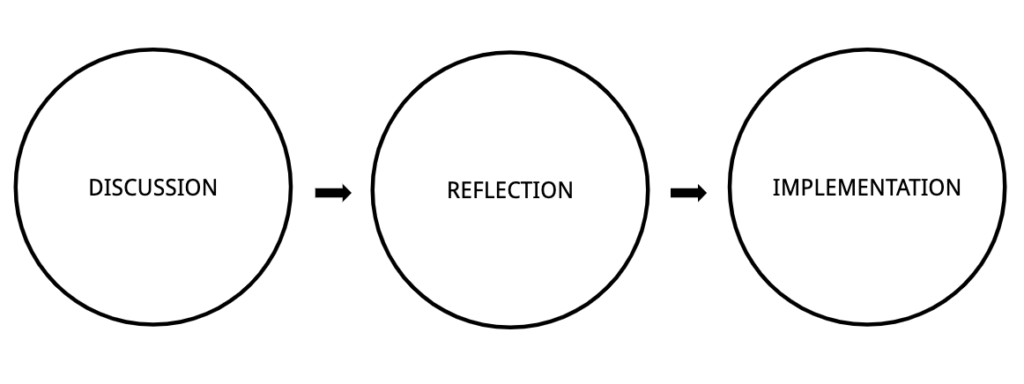Whether in our personal or professional lives, we are constantly giving and receiving feedback. Some of the feedback is subtle, often unconscious, and some of it is proactive. Being able to receive and to offer constructive feedback is an essential skill in building meaningful social relationships.
In addition, research suggests that meaningful feedback is crucial to improve our performance. Constructive criticism can guide us, motivate us, reinforce effective behaviours, and reduce ineffective behaviours. So how can we make the most of it?

The keys to giving constructive criticism
Offering constructive criticism is a complex exercise, where the goal is keep a balance between delivering feedback and respecting the recipient’s emotions.
Before you give feedback to someone, make sure you are doing for the right reason: helping them grow and improve. If you are doing it because you are in a bad mood or trying to make yourself powerful, consider a self-reflection session instead of giving feedback.
If you are doing it for the right reasons, apply these strategies to make sure the person can make the most of your feedback.
- Be specific and realistic. There is nothing worse than receiving vague or unreasonable feedback. Focus on specific aspects to be improved, and provide examples as practical illustrations. It’s important to ensure you are giving feedback on elements that can actually be improved. It can be frustrating for the person if they have no control over the relevant factors. Make sure to ask the person if the feedback makes sense, so they can ask follow-up questions if needed.
- Find the right time. Untimely feedback can be badly received. First, don’t delay giving feedback. The faster you give feedback, the faster the person can improve their behaviour. However, it can be useful to not give feedback on the spot, especially if you are in a group. Wait until you can talk to the person one-to-one, find a quiet spot, and make it as comfortable as possible for both of you.
- Focus on the behaviour. Don’t judge the person. Instead, describe the behaviour you have observed, and explain how it makes you feel or what it makes you feel. For example: “I have noticed you have been late several times this week. I’m worried you may be late on your current project. Can we talk about it?”
- Balance the feedback. Some people call it the sandwich approach. The goal is not to sugarcoat your feedback, but to remind the person of the fact that you value them, and this is why you are taking the time to share feedback. This is also a good opportunity to reinforce what they should keep on doing.
- Offer support. Criticism cannot be constructive if you don’t offer alternative behaviours, and if you don’t support the person in the long run. Feedback is a continuous process. Make sure to be available to help, and let them know when you notice progress.
A great way to gauge how you have delivered feedback is to ask yourself: how would I react if I received this exact feedback, delivered in this exact manner?
And if you are in a managerial position and want to improve the way you give feedback, you may even use your bottom-up performance reviews to ask your team members: “How did I do when I gave you feedback? Anything I could have improved?”
Receiving feedback effectively
If you are often giving feedback and not receiving any, you may have built a wall around yourself that makes it difficult for people to comfortably share constructive criticism with you. So the first step is to invite feedback from other people.
- Be open. Make it clear to the people around you that you welcome constructive criticism and are receptive to different opinions. Fostering psychological safety around you is crucial to attract meaningful feedback that will help you learn and grow as a person.
- Stay in control of your responses. Receiving negative feedback can be emotionally difficult to handle. As much as you can, try to stay calm and focused. Looking angry or distracted will not help the person confidently share feedback with you. A safe reaction to have in the first few minutes is to listen and nod to show you are attentive.
- Make sure you understand the feedback. Once the person is done sharing the high-level overview of their feedback, ask questions to clarify anything you didn’t understand or would like more details on. For instance, you could have understood what they think you did wrong, and may want to ask about potential alternative behaviours.
- Reflect on the feedback. Thank the person for their feedback, then reflect on it on your own. Receiving feedback does not mean you need to accept it or incorporate it. Think about its value and merit, and decide whether to use it or discard it.
- Cultivate a growth mindset. Whether you decide to implement the feedback or not, ask yourself: is there anything I can learn from this conversation? Sometimes, the feedback you receive can be a symptom of another area of potential improvement. Maybe the information was miscommunicated, maybe you made a wrong assumption, maybe the team is missing some resources.
Giving and receiving feedback is an art. Because these conversations can be perceived as negative, it’s important to apply thoughtful strategies to better manage our emotions. Implementing these principles can help make constructive criticism a positive drive in your personal and professional interactions.
